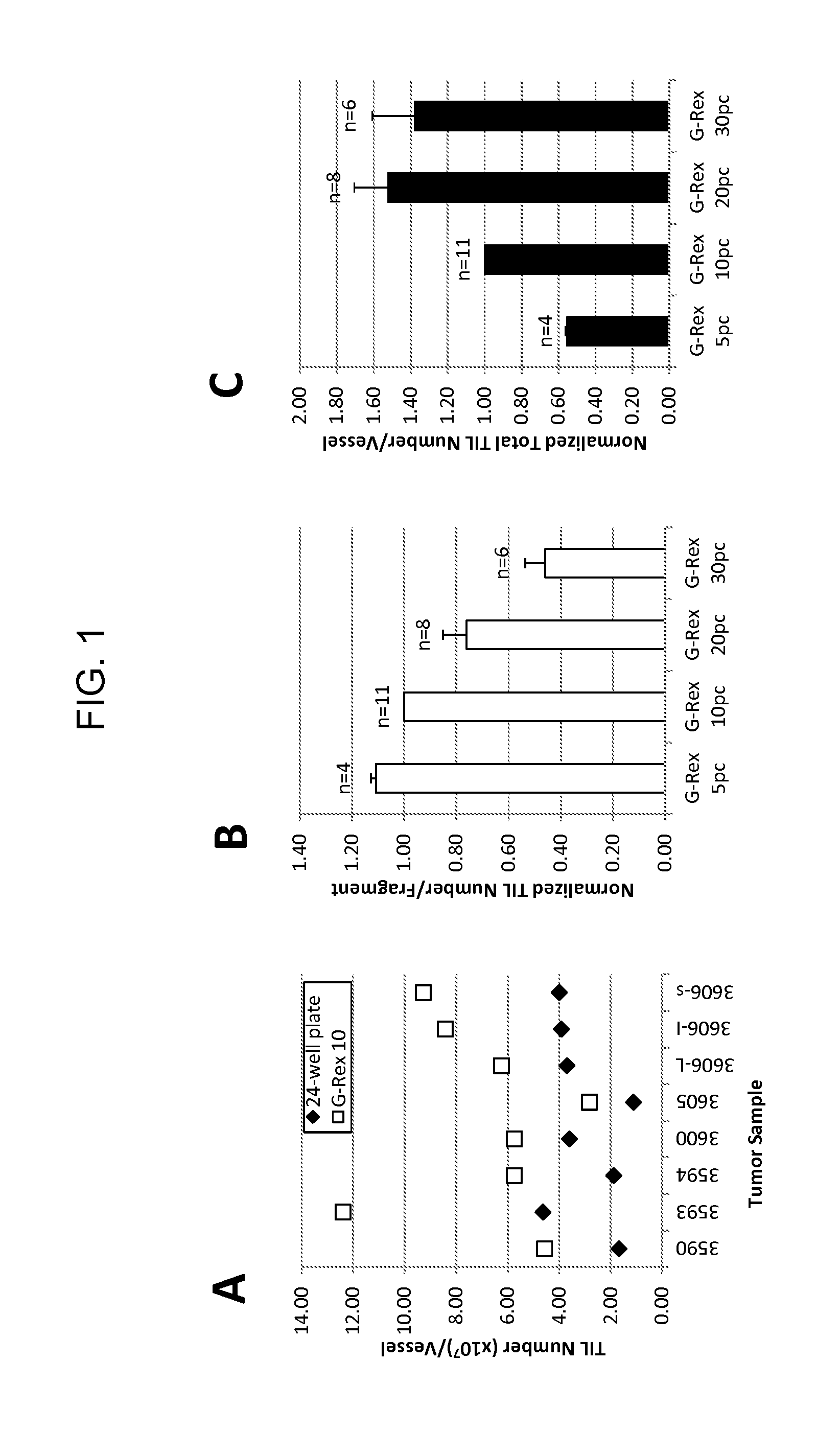Methods of growing tumor infiltrating lymphocytes in gas-permeable containers
a technology of infiltrating lymphocytes and gas-permeable containers, which is applied in the directions of biocide, antibody medical ingredients, drug compositions, etc., can solve the problems of technical, regulatory, logistical and logistic challenges introduced
- Summary
- Abstract
- Description
- Claims
- Application Information
AI Technical Summary
Benefits of technology
Problems solved by technology
Method used
Image
Examples
example 1
[0059]This example demonstrates that TIL cultured in gas-permeable containers is better than, or at least comparable to, that in a 24-well plate.
[0060]The growth of TIL from tumors using gas permeable flasks with a 40 mL capacity and 10 cm2 gas permeable silicone bottom (G-Rex10, Wilson Wolf Manufacturing Corporation, New Brighton, Minn., USA (providing about 10 cm2 of surface area for growth of the TIL)) or 24-well plates (Corning Corning, N.Y.) was compared. A total of 14 melanoma samples were tested, including 9 freshly prepared tumor digests (Table 1A) and 5 thawed samples from previously frozen tumor digests (Table 1B). TIL from frozen tumor from patient 2653 were not able to be cultured in either the G-Rex10 or 24-well plates. Except for one fresh sample (#3522), the ratio of harvested TIL to initially seeded cells at day 17 to 29 was similar to or better in the G-Rex10 flasks than in the 24-well plate (Table 1A and 1B).
TABLE 1AComparison of initial TIL culture in G-Rex10flask...
example 2
[0063]This example demonstrates that the culture of TIL from tumor fragments in gas permeable flasks produces a greater number of TIL as compared to culture in 24-well plates after 7 to 13 days.
[0064]The growth of TIL from tumor fragments in G-Rex10 flasks or 24-well plates was next compared. For each tumor sample, fragments approximately 1 to 8 mm3 in size were seeded into 24-well plates at 1 piece per well and into G-Rex10 flasks at 5, 10, 20, or 30 pieces per flask. The growth of TIL from 2 lymph nodes and 1 liver metastasis was assessed (Table 2). TIL could be grown from tumor fragments in both gas-permeable flasks and 24-well plates, but after 7 to 13 days greater quantities of TIL were obtained from the G-Rex10 flasks than the wells (Table 2).
TABLE 2Initial TIL culture using tumor fragments in G-Rex10 flasks and 24-well plates.PatientNumber of CellsNumber and# of TILTILTIL PhenotypeTumorCultureTumorTIL#perViability(% TIL expressing each antigen)SourceVesselFragments*(Day 7-13)...
example 3
[0066]This example demonstrates the kinetics of TIL growth in gas-permeable flasks.
[0067]In order to assess the kinetics of TIL growth in gas-permeable cultureware, TIL from one patient were cultured in G-Rex100 flasks seeded at a density of 5×106 and 10×106 cells per flask. The cells were counted daily after day 6. On Day 6 the number of cells in the G-Rex100 flask seeded at 5×106 cells was 255×106 cells and at 10×106 cells was 300×106 cells. The quantity of TIL in G-Rex100 flasks seeded at each cell density increased steadily until day 9, but there was little increase in cell counts between days 9 and 10. After 10 days 906×106 cells were harvested from flasks seeded with 5×106 TIL and 1,050×106 cells from flasks seeded with 10×106 TIL. Although TIL expanded well for 9 days, in order to keep the G-Rex100 flask expansion process similar to REP in T-flasks and gas-permeable bags where TIL are transferred from T-flasks to bags on day 7, further studies focused on TIL expansion in the ...
PUM
| Property | Measurement | Unit |
|---|---|---|
| Volume | aaaaa | aaaaa |
| Volume | aaaaa | aaaaa |
| Height | aaaaa | aaaaa |
Abstract
Description
Claims
Application Information
 Login to View More
Login to View More - R&D
- Intellectual Property
- Life Sciences
- Materials
- Tech Scout
- Unparalleled Data Quality
- Higher Quality Content
- 60% Fewer Hallucinations
Browse by: Latest US Patents, China's latest patents, Technical Efficacy Thesaurus, Application Domain, Technology Topic, Popular Technical Reports.
© 2025 PatSnap. All rights reserved.Legal|Privacy policy|Modern Slavery Act Transparency Statement|Sitemap|About US| Contact US: help@patsnap.com

